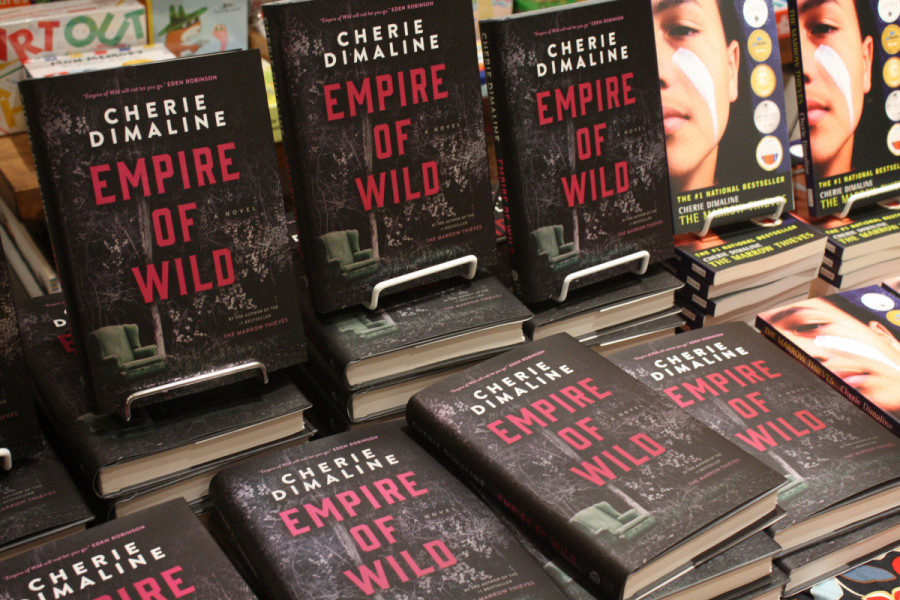Métis Author Cherie Dimaline Launched Anticipated Book
Fans of ‘The Marrow Thieves’ Flock to D&Q to Celebrate ‘Empire of Wild’
The Drawn & Quarterly bookstore filled with applause as Cherie Dimaline took to the front of the room on Oct. 30.
A small crowd filled the rows of old wooden school chairs and listened attentively as Tara McGowan-Ross, Mi’kmaw artist and author, interviewed Dimaline about her newest novel, Empire of Wild, published on Sept. 17.
McGowan-Ross described Empire of Wild as a captivating read that is difficult to put down, especially during a “well-planned bout of insomnia.”
The novel, based on a traditional story the author grew up with, follows protagonist Joan’s quest to remind her disillusioned husband Victor who he is.
After the unprecedented success of her last novel, The Marrow Thieves, Dimaline felt a lot of pressure to put out something equally outstanding.
Related“I saw over 100,000 high school kids last year who were studying the book, who would line up for three hours to talk to me or get my signature,” said Dimaline.
Her dedicated young readership even created Instagram accounts and Facebook profiles for the novel’s characters.
“For me, the idea of kids, all Canadian kids, learning about philosophy, about history, about science, about psychology, about wellness, from an Indigenous lens is really, really such an honour.” — Cherie Dimaline
Dimaline recalled the experience as being amazing, but felt she was unprepared to deal with the passion and expectations The Marrow Thieves unleashed.
“There were a lot of people paying attention to what was coming next […] and I froze for a bit,” said Dimaline. “I was like, ‘What if I never write again [and] everything I have is garbage from this point?’”
“I realized I should probably just go home, home to where my stories are,” she said.
She unexpectedly got an opportunity to do so later that year at a conference at Rama First Nation in Ontario.
Related“I was completely unprepared, I thought I was going there to do a panel discussion with other writers and it turned out we [each] had to stand up and give a lecture for 25 minutes,” recalled Dimaline.
In the heat of the moment, she decided to tell a traditional story she grew up with: that of the Rogarou. She promptly fell in love with the tale all over again.
Dimaline, a member of the Georgian Bay Métis Community, described the Rogarou as “a terrifying creature […] a large black dog who walks like a man, who is also kind of funny and witty, so he draws you in.”

“He was a cautionary tale for us to be safe to stay together, to never be alone at any point in time,” recounted the author.
In addition to traditional stories passed down in the Métis community where she grew up, Dimaline turns to poetry and politics for inspiration.
“I can’t write poetry to save my life, [but] there’s something about distilling all those thoughts and ideas […] that is so inspiring to me,” she explained.
Dimaline also weaves political issues faced by Indigenous people into her writing. For Empire of Wild, she drew from personal experience with resource extraction on the land she was raised on, she explained.
“There’s always something to be passionate about or upset about in an Indigenous community,” she said.
Related“We are a very strong, vibrant, diverse, loving people and if we keep just telling the trauma without the context […] our children will think they are broken, and our children are not broken, they are everything that we need to move forward.”
Dimaline hopes her work can provide people with the tools to do better than the settlers did. She feels blessed that Canadian schools are replacing To Kill a Mockingbird, an American novel about slavery in the South, with The Marrow Thieves in curriculums across the country.
“For me, the idea of kids, all Canadian kids, learning about philosophy, about history, about science, about psychology, about wellness, from an Indigenous lens is really, really such an honour,” said Dimaline.


_600_832_s.png)
